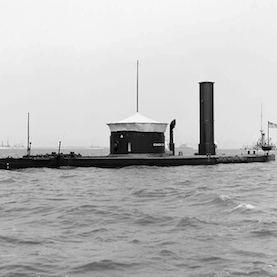* Secession not only spurred rapid improvements in warships and weapons, but also led to advances in communications and medicine
By James Marten, Scientific American
Any Civil War buff is familiar with the technological advances of that era: the carnage caused when tactics failed to accommodate breech-loading rifled muskets and artillery pieces, the truly revolutionary introduction of armored ships and railroad networks, and the merely tantalizing deployment of submerged warships and reconnaissance balloons. Historians still argue about the extent to which the Civil War was the first “modern” war, but it is impossible to deny that the technology with which it was fought foretold the ways in which future wars would become bigger, bloodier and more devastating. Fewer people realize, however, that a similar explosion in technological creativity occurred away from the battlefield.

IRON-CLAD SHIP U.S.S. Canonicus, launched in 1863 by the Union navy, was just one of many military innovations made during the Civil War. Image: Library of Congress, Prints & Photographs Division, Detroit Publishing Company Collection, LC-D4-22439
Newspapers became tools of mass communication in the 1830s with the invention of the rotary press and the application of steam power to printing. These and other innovations brought down the price of newspapers; by the 1830s and 1840s newspapers such as the trio of New York papers founded during this time—theTribune, the Sun and the Herald—were sold for a penny and reached massive audiences. The development of the telegraph in the late 1840s sped the gathering and distribution of news; the Associated Press was founded in 1849 to take advantage of the new technology. The gradual knitting together of the nation by railroads—especially in the North and Midwest—further hastened communication.
During the antebellum years, these communication technologies facilitated the anti-slavery campaign that started in earnest in the early 1830s, allowing abolitionist broadsides, brochures, books and newspapers to be distributed cheaply and widely throughout the North and helping Frederick Douglass and other abolitionist speakers spread their message to northern towns large and small. Indeed, it could be argued that the rapid expansion of communication technologies in the decades leading up to the war, which made it easier for reformers to get their arguments out, gave abolitionists a far greater role in the sectional conflict than their numbers would suggest.
Once the war started, communications technologies ensured that Americans would have much better access to war reports and images than in any previous war. Hundreds of newspaper reporters traveled with armies from Virginia to Mississippi, bringing news to soldiers’ families back home faster than ever before. Although often wildly inaccurate—newspapers ran stories without checking facts or independently confirming accounts—they pulled civilians into the war. Newspapers were filled with stories and maps and casualty lists; people who had been children during the Civil War recalled years later that they had eagerly followed the progress of “their” armies—in which fathers or older brothers often marched—through their local papers.
Magazines such as Frank Leslie’s Illustrated Newspaper and Harper’s Weekly went a step further: They sent dozens of intrepid professional artists and illustrators into the field—Alfred Waud and Winslow Homer were only the most famous—and employed the fairly new technology of “electrotyping,” which used a combination of chemicals and electric current to make more detailed and easily reproduced prints. As a result, these “illustrated weeklies” could show realistic images of the war in as little time as a few days. Readers could see lines of battle or columns of retreating men, dead and wounded soldiers, freed slaves and war heroes.
Like other weeklies of the time, the Scientific American covered the Civil War extensively, with a lengthy section of each issue devoted to reports of the latest skirmishes and assessments of the situation—including naval activities along the coast. In addition to these field reports, the magazine also published hundreds of articles about the new technologies that were being deployed during the war or tested for possible use. Almost every issue that appeared during the war years contained multiple articles on the newest developments in the construction of warships and weaponry. A sampling of those articles, which focused on the technology of the war rather than its chronology, appears in this Scientific American Classics compilation.
If the development of mass communication technologies during this period made the war seem more real to civilians, a very different stream of technological innovation reflected the grim actualities of war during the years afterward. The thousands of men maimed by the improved arsenals of both armies inspired entrepreneurs to design new and improved prosthetic limbs. The Patent Office granted 133 patents for artificial limbs and other prosthetic devices between 1861 and 1873; at the same time, the federal government and many states also established programs that distributed artificial arms and legs to veterans free of charge.
The empty sleeve and the crutch became the most obvious symbols of patriotism and sacrifice in the years following the war. Perhaps 60,000 men survived the war as amputees, and inventors and investors sought to make the prosthetics industry more profitable by turning out more realistic-looking artificial arms and legs. They used natural woods, dyes and leather covering to make artificial limbs appear more natural, but also tried to make them more functional by inventing new types of joints, ball bearings, springs and rubber bands to substitute for ligaments and tendons, and other mechanical innovations to try to create a natural gait and to allow men to conceal their disability if they so desired. A promotional book by one manufacturer of prosthetic limbs attributed the growing markets for entrepreneurs and inventors to the bloody, increasingly industrialized wars of the 1850s, 1860s and 1870s—when the British, French and Russians fought in the Crimea; the United States and Confederacy fought in America; and Prussia crushed France.
In words that no doubt represented the attitudes of most of the inventors of the technologies described in the following pages, one inventor of prosthetic limbs bluntly stated “the bent of human ambition is for the acquisition of money instead of a few plaudits from the world.” The Civil War provided a huge market for the application of new technologies to the myriad facets of warfare, from the political to the medical. Most of the inventions and ideas reported by the Scientific American during this crisis probably failed to earn fortunes for anyone. But they were nevertheless part of the grim yet creative application of technology to the challenges and opportunities created by the Civil War.
ABOUT THE AUTHOR(S)
JAMES MARTEN is a professor and chair of the history department at Marquette University and former president of the Society of Civil War Historians. He has written and edited more than a dozen books, including Children and Youth during the Civil War Era (NYU Press, 2012), Sing Not War: The Lives of Union and Confederate Veterans in Gilded Age America (University of North Carolina Press, 2011) and Civil War America: Voices from the Home Front (Fordham University Press, 2007). He is currently working on a biography of James R. Tanner—better known as “Corporal Tanner”—a Civil War veteran who lost both feet at Second Manassas and became famous as an orator, Republican operative, and promoter of the Grand Army of the Republic and of veterans’ pensions.



